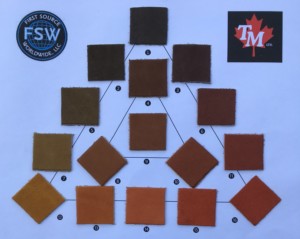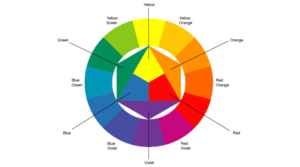Trichromatic Color System For Dying Leather
Color matching was quite an art 50 years ago in any industry where color was a part of the production process. From glass cleaners to painted finishes, color is critical to all finished products that go to market. In recent years, spectrophotometer technology has made developing new colors and maintaining consistency of lots and batches easier as it becomes less costly and more versatile with the introduction of portable units and improved software. However, in leather, this technology does not replace experience when compared to other industries. The variables in the leather making/dying process are well known and solutions suitable for other industries don’t often translate well for dying leather. It’s critical for tanneries to have experienced tanners and color matchers on staff as well as to partner with dye suppliers who can provide a consistent and well thought out dye portfolio. Using a trichromatic color system in leather may not work to create all your colors, but a modified version of the same theory using three contrasting brown dyes with similar chemical characteristics is a great solution for reducing inventory, improving predictability, and maintaining consistency.

Reduced Inventory = Reduced Costs
Many companies have offered “trichromatic” color solutions over the years, some even going so far as to offer 3 dyes to replace all the dyes in your dye house. Although great in theory, dyes on leather don’t always work out as we’d like. In theory, mixing combinations of the 3 primary colors should provide us with every possible color imaginable. It may be the perfect solution for pigment coatings, but dying leather is something unique. Where coatings will cover the substrate when applied (such as paint on a wall), dyes react with the leather fibers, and the number of variables that affect the outcome are limitless. Time, temperature, mechanical action, pH, penetration, concentration, solubility, and more will affect the outcome. A technician may mix up some dyes in solution and arrive at a desired color when tested on paper, but it doesn’t always work out on leather. A shot of formic acid can shift a red cast dye to green, a syntan can have a bleaching effect on a bright color, sometimes a red dye will penetrate less than other colors in a mix, etc. But that doesn’t mean there isn’t a place for a trichromatic dye system in leather, it just means that you need to focus on leather in a way that reduces the effects of the variables on the outcome while the development stages occur. And let’s face it, since we’re talking about leather, most of what we’re talking about it going to be various shades of brown. So our system is only going to help us make various shades of brown and by using dyes that are chemically similar in particle size, pH, and solubility. We can match most any brown shade using the 3 shades of brown shown in the triangle below. Some of our customers have replaced 10 to 15 different brown dyes using only these 3 dyes…that’s quite a savings!

Improving Versatility/Predictability
So now that we’ve loaded all your obsolete dyes into the disposal truck, we have a lot of work to do! It’s no small task reformulating all your colors but let’s say we’ve done just that and you only have 3 dyes to work with. The benefit is one that will come down the road… when the sales staff show up with a swatch that needs to be matched and costed for a customer. Color matching is quicker and more predictable since the dyes are designed to work and mix together in similar pH ranges and temperatures. When matching a new color, it’s important to know that what you see on a paper dip will translate onto a piece of leather. Cutting down R&D time is one of the benefits you could realize when your team starts every color match project using the same 3 dyes.
Maintain Consistency
Now the most important benefit of all! Predictable outcomes mean fewer QC fails and subsequent reworks on drum loads of leather. There are always changes from load to load such as water temperature, pH, hide/skin density, etc. All these factors could affect the how the dye will stain the leather fibers. Using a simple dye system with fewer dyes that are chemically similar will help mitigate the effect of unavoidable load to load variables. This translates to a reliable load to load outcome reducing reworks and QC fails down the road. Not only another way to save time and money, but a better experience for your customer.
I think we’d all agree that fewer dyes in the stockroom is better for the bottom line. So why not have a look at one of our trichromatic dye systems for yourself. Once you have your core dyes selected, dye out the core colors and some simple combinations on your own leather. Then try matching a few of your core colors and see how easy it is to work with. I’m sure you will find the consistency and repeatability to your liking. You may even want to explore the possibility of creating your own based on dyes you are already comfortable using. Our color experts can help in either case. The savings are real if you are willing to put in the work at the beginning of the project. Your customers will thank you. Feel free to contact us by clicking the picture below!



